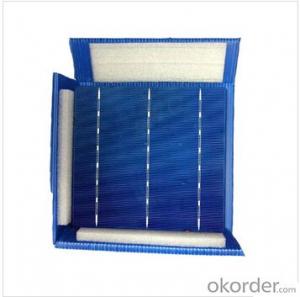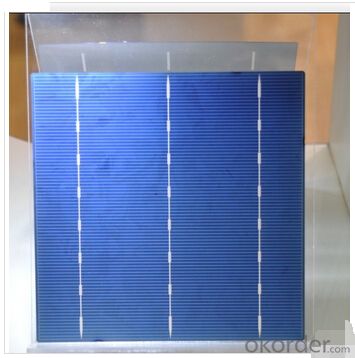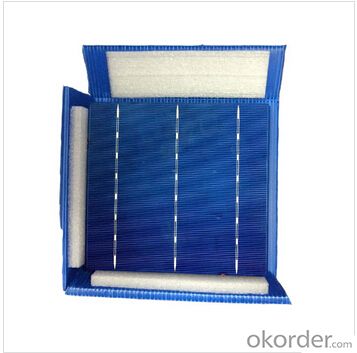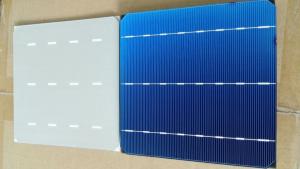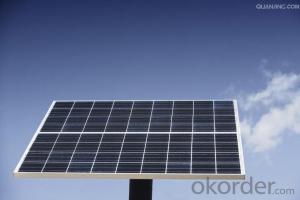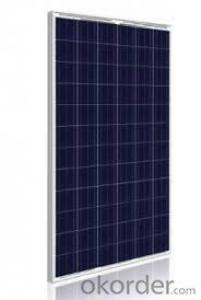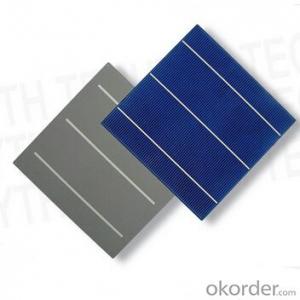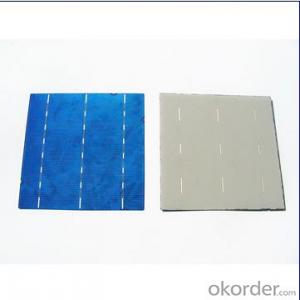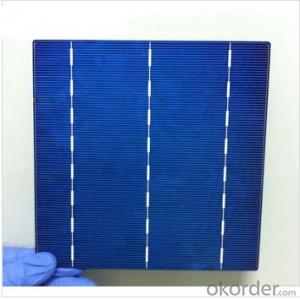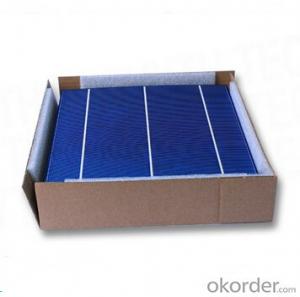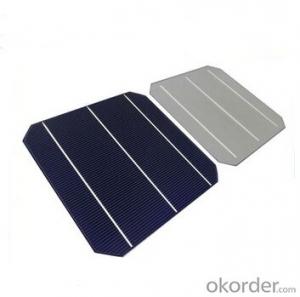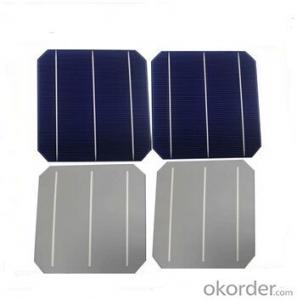Multiband Polycrystalline Solar Cells Series - CM16.80
- Loading Port:
- Shanghai
- Payment Terms:
- TT or LC
- Min Order Qty:
- 3000 pc
- Supply Capability:
- 300000 pc/month
OKorder Service Pledge
OKorder Financial Service
You Might Also Like
Solar Cells:
Solar cells is made by solar wafer, it has three categories of solar cell right now, monocrystalline polycrystalline and thin film,These cells are entirely based around the concept PN junction, which is the critical part of solar module, it is the part that can convert the light energy into electricity, the thickness is from 180um to 200um, with even busbars to conduct electricity, textured cell can decrease diffuse reflection; they are often electrically connected and encapsulated as a module. Photovoltaic modules often have a sheet of glass on the front (sun up) side, allowing light to pass while protecting semiconductor wafers from abrasion and impact due to wind-driven debris, rain, hail, etc. Solar cells are also usually connected in series in modules, creating an additive voltage. Connecting cells in parallel will yield a higher current;With high quality and stable quality. Our Cells can greatly improve the performance of Solar Modules.
Features:
1. High conversion efficiencies resulting in superior power output performance.
2. Outstanding power output even in low light or high temperature conditions
3. Optimized design for ease of soldering and lamination
4. Long-term stability, reliability and performance
5. Low breakage rate
6. Color uniformity
Solar Cells Advantage:
1. Tire-1 Solar Cells’ Manufacturer Quality Guarantee. With a complete and sophisticated quality government system, our Quality Management have arrived world’s leading place. Customer can receive Tire-1 Cells Maker’s Quality Standard Products.
2. Trusted Warranty. We can supply trusted after-sales service to our customer. If our cells are found not in conformity to the specification of manufacturer, or should the inspected quantity found in shortage, or should the packing found damaged, the buyer has the right to claim to the seller. The claim, if any, should be presented to seller within 30 days after cargo's arrival date to the port, together with related inspection report and photos issued and provided by a reputable independent surveyor such as SGS.
3. World’s Leading Manufacturer Equipment. We imported the newest and leading production equipment from abroad. Advanced equipment can guarantee the stable quality of cells. Auto production line can also save labor cost which will further cut our production cost.
4. Bulk supply: With the production capacity of 500MW, we can produce large quantity every month. This can satisfy most customer requirement.
Specifications:
Kit content:
Product: multicrystalline cell based on poly silicone
Format: 156mm*156mm ± 0.5mm
Front contacts (-): 3*1.5mm wide bus bars(silver), acid texturized surface, blue silicone nitride antireflection coating
Back contacts (+): 3*3mm wide bus bars(silver/aluminum), aluminum backside metallization
Warranty:
Repairs: For repairs please contact to us
Exchange service: You can choose between a refund, exchange or credit where goods are faulty or doesn’t do what it supposed to do
Model | CM16.80% |
Max power | 4.1W |
Short-circuit current(Isc) | 8.41A |
Imax at 0.5V | 8A |
Open circuit voltage(Voc) | 0.62V |
Size | 156*156mm |
Efficiency | 16.80% |
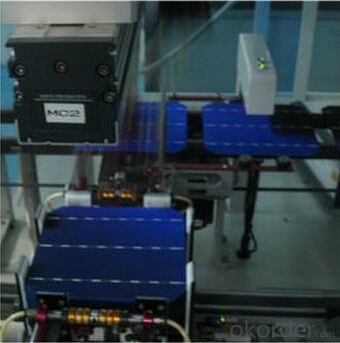
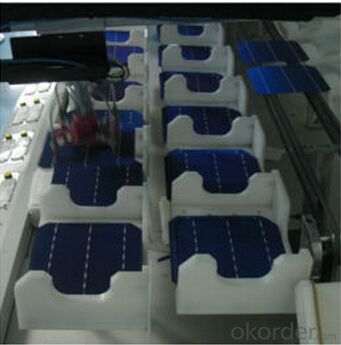
FAQ
We have organized several common questions for our clients,may help you sincerely:
①What price for each watt?
It depends on the efficiency of the solar cell, quantity, delivery date and payment terms.
②How long can we receive the product after purchase?
In the purchase of product within three working days, We will arrange the factory delivery as soon as possible. The pecific time of receiving is related to the state and position of customers.Commonly 7 to 10 working days can be served.
③Can you provide the peripheral products of the solar panels, such as the battery, controller, and inverter? If so, can you tell me how do they match each other?
Yes, we can, we have two companies for solar region, one is CNBM International, the other is CNBM engineering Co.
We can provide you not only the solar module but also the off grid solar system, we can also provide you service with on grid plant.
④What is your warranty of solar cell?
Our product can promise lower than 0.3% open box crack, we support claim after opening the box if it has crackm color difference or sth, the buyer should give pictures immediately, we can not accept the claim after the solar cell has assembled to solar panel.
• Timeliness of delivery
• ⑤How do you pack your products?
We have rich experience on how to pack the solar cell to make sure the safety on shipment, we could use wooden box or pallet as buyer's preference.
How Much Do Solar Panels Cost
How much do solar panels cost? This is undoubtedly the question we`re asked the most, and unfortunately it has no straightforward answer. We decided to pull together all aspects of this question, and write the best resource on the costs of solar panels you will find on the entire Internet.
Residential solar systems are typically sized from 3 to 8kW and end up costing between $15,000 and $40,000. The cost per watt (price inclusive of parts, labor, permitting fees, overhead, and profit) has decreased significantly over the last decade and is now between 6 and 8 ($/W) in many parts of the U.S. Generally, the bigger the system, the lower the cost per watt.
The total costs are split into system, installation and operational costs, roughly in the following ratios:
Contents
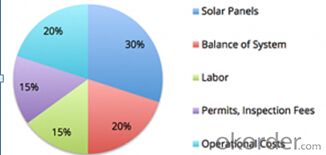
How Much Do Solar Panels Cost Today?
Solar panels themselves are now a global product. There’s tremendous variation in the cost of solar panels based on the type and efficiency of the solar panels. However, the type of panels used for residential solar installations is quite standard and the costs are basically set globally. That cost has fallen tremendously within the past few years — they’re now about half the price they were in 2008, and more than 100 times lower than they were back in 1977.
The average weekly spot price for polysilicon solar modules this week is $0.55/watt. For a thin-film solar modules, it’s $0.55/watt. For residential solar modules, which are typically of a higher efficiency than solar modules used in utility-scale solar farms, the figure would be a bit higher. But how much does this solar cost info really help you?
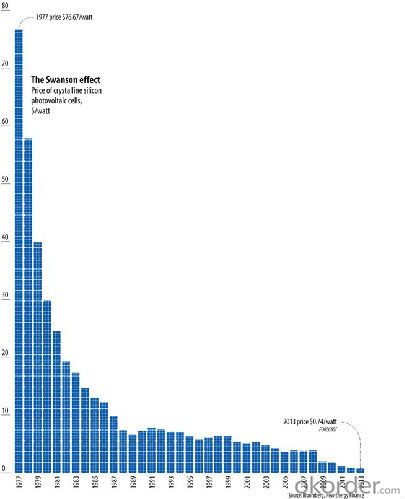
- Q: How do solar cells perform in areas with frequent earthquakes?
- Solar cells are designed to withstand earthquakes to some extent, but the performance can be affected depending on the severity of the earthquake. If the solar cells are properly installed and secured, they can generally withstand moderate earthquakes without significant damage. However, in areas with frequent and strong earthquakes, additional measures like reinforced mounting systems may be necessary to ensure the long-term performance and durability of the solar cells.
- Q: How do solar cells perform in areas with high levels of humidity?
- Solar cells generally perform slightly less efficiently in areas with high levels of humidity. This is because the moisture in the air can scatter and absorb some of the sunlight before it reaches the solar cell, reducing its overall power output. However, modern solar cell technologies have been developed to minimize this effect and maintain a satisfactory performance even in humid conditions.
- Q: Can solar cells be used in theme parks or amusement parks?
- Yes, solar cells can be used in theme parks or amusement parks. Solar panels can be installed on rooftops, parking structures, or open areas within the park to generate renewable energy. This energy can be used to power rides, lighting, and other facilities, reducing reliance on traditional electricity sources and lowering operating costs. Additionally, incorporating solar technology aligns with the sustainable and eco-friendly image that many theme parks strive to promote.
- Q: What is a polymer solar cell and how does it work?
- Polymer cells are actually a type of thin film solar cell,
- Q: How do solar cells perform in desert environments?
- Solar cells perform exceptionally well in desert environments due to the abundance of sunlight and high temperatures. The vast open spaces and lack of cloud cover allow solar panels to receive maximum exposure to sunlight, resulting in higher energy production. Additionally, the dry and arid conditions in deserts help reduce dust and dirt accumulation on panels, ensuring optimal performance and efficiency.
- Q: How much does a solar cell cost?
- If you want to know how much a solar cell cost, it might take you longer time than you thought.
- Q: How do solar cells perform in areas with extreme temperature fluctuations?
- Solar cells typically perform well in areas with extreme temperature fluctuations. However, excessive heat can slightly reduce their efficiency, while extreme cold can temporarily decrease their power output. Nonetheless, solar cells are designed to withstand a wide range of temperatures, and advancements in technology have improved their performance and durability in extreme weather conditions.
- Q: How do solar cells compare to fossil fuels in terms of energy production?
- Solar cells have several advantages over fossil fuels in terms of energy production. Firstly, solar cells harness renewable energy from the sun, while fossil fuels are non-renewable and finite resources. Secondly, solar cells produce clean energy, emitting no greenhouse gases or pollutants, whereas fossil fuels release harmful emissions that contribute to climate change and air pollution. Additionally, solar cells can be installed on rooftops or in remote areas, making energy production more decentralized and less reliant on centralized power plants. However, solar cells currently have limitations in terms of efficiency and storage capacity, which fossil fuels have a higher energy density and can provide continuous power supply. Overall, solar cells offer a sustainable and environmentally-friendly alternative to fossil fuels, but further advancements are needed to fully replace their energy production capabilities.
- Q: Can solar cells be used in concert venues?
- Yes, solar cells can be used in concert venues. They can be installed on the rooftops, facades, or parking areas of concert venues to generate clean and renewable electricity. Solar energy can power various aspects of the venue, such as lighting, sound systems, and other electrical equipment, reducing the reliance on traditional energy sources and lowering carbon emissions. Additionally, solar panels can be integrated into portable structures to provide power for outdoor concerts and festivals.
- Q: How are solar cells installed on rooftops?
- Solar cells are typically installed on rooftops through a process that involves assessing the roof's suitability, preparing the surface, mounting the solar panels, connecting them to the electrical system, and ensuring proper wiring and grounding for optimal performance.
Send your message to us
Multiband Polycrystalline Solar Cells Series - CM16.80
- Loading Port:
- Shanghai
- Payment Terms:
- TT or LC
- Min Order Qty:
- 3000 pc
- Supply Capability:
- 300000 pc/month
OKorder Service Pledge
OKorder Financial Service
Similar products
Hot products
Hot Searches
Related keywords

